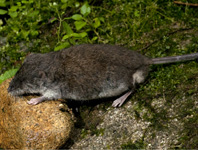Abstract
The island of Sulawesi, in Indonesia, lies at the crossroads of the Indo-Australian Archipelago and has remained isolated from the Asian (Sunda) and Australian (Sahul) continental shelves for at least the last 10 million years. Of the 50 native species of rodents on Sulawesi, all are endemic and represent the evolution of a variety of ecological and morphological forms within the Muridae and Sciuridae. Carnivorous rodents have evolved, perhaps independently, in Muridae from the Philippines, Sulawesi, and Sahul, but semi-aquatic murids are only known from Sahul. Here we describe a new genus and species of insectivorous water rat from Sulawesi. Phylogenetic analyses demonstrate that it is related to the shrew rats of Sulawesi and represents an origin of aquatic carnivory that is independent from the evolution of water rats on Sahul. Many areas of Sulawesi have not been surveyed systematically and current lists of mammal species are likely to dramatically underestimate actual diversity.

